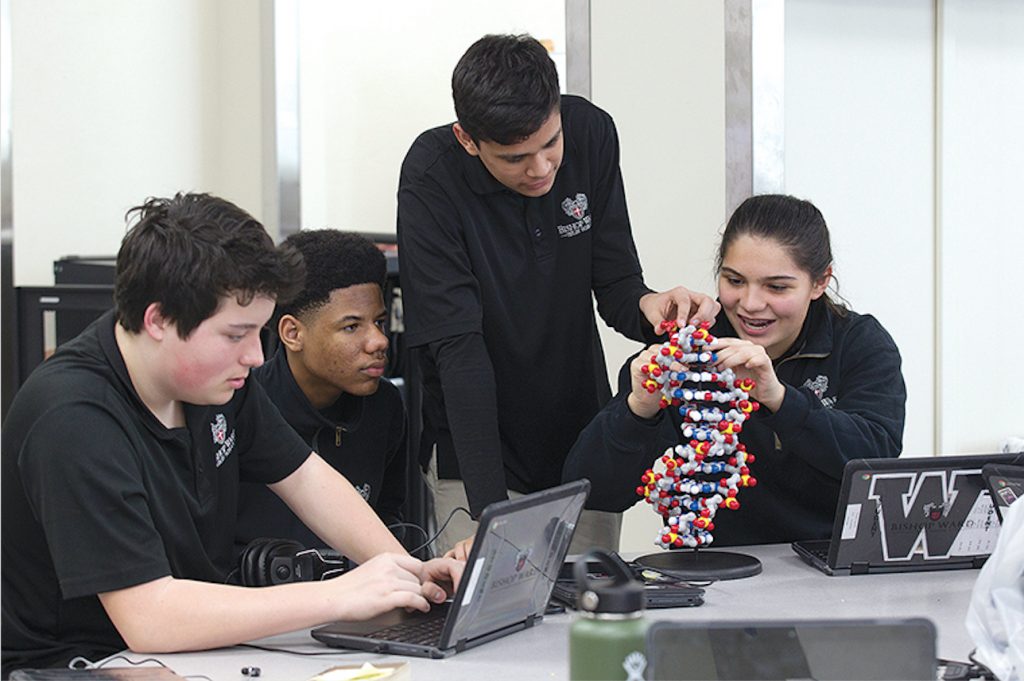
by Olivia Martin
olivia.martin@theleaven.org
KANSAS CITY, Kan., — In the heart of the city on 18th Street here, there is a place where 3D printers, hydroponic towers, biomedical instruction and art meet.
At Bishop Ward High School’s STEAM program — STEAM stands for science, technology, engineering, art and mathematics — the mission is simple.
“We believe science is an active verb,” explains Ignacio Alonso, the chairman of the science department at Ward.
“Students have to be able to do science, not just learn it,” he added.
And that’s where the STEAM program comes in.
A different way of teaching
“I have a lot of students who come in from elementary school and say they hate science,” said Alonso.
But actually, Alonso has found, they hate the way science is taught.
“When we change the way we teach science so the kids can actually explore and use their imagination and their hands,” he continued, “the difference in engagement we see is amazing.”
Fortunately, Ward is making hating science a thing of the past.
“I think Ward has helped me like science more,” said freshman Meg Mahoney. “At my old school, I didn’t enjoy having science. But having the right teacher and lessons have really helped me like [it] more.”
Fellow Ward freshman Joe Hernandez said he feels more engaged in science class because of the STEAM program.
“I feel like they are taking science as seriously as it should be taken,” he said.
Bishop Ward has partnered with Project Lead The Way (PLTW), a national initiative that provides various STEM curriculum options, as well as summer training for educators.
“The [teacher] training is very intensive,” said Alonso, “because, in two weeks, you have to do all of the work the students are going to do during the entire year.”
Ward currently offers two of PLTW’s four options within its biomedical studies curriculum — principles of biomedicine and human body systems.
It plans to add a third course on medical innovations soon.
After students complete three of the biomedical courses, they will receive a certification of participation from PLTW, that they can add to their resume.
Cross-curriculum learning
The apprentice-like approach to education does not stop at the threshold of Ward’s St. Francis of Assisi STEAM lab.
“Now that we have seen how this method of teaching works with PLTW,” said Alonso, “we have started incorporating that with all the other classes.”
From this desire to implement a new method of teaching has emerged a new move toward cross-curriculum instruction and learning at Ward.
This is why, for example, Ward’s program is called STEAM instead of STEM, including art in the program design and acronym.
“Art and science have been together forever,” said Alonso.
The great Renaissance scientist and artist Leonardo da Vinci is a prime example.
“That connection, for us, is important because we are trying to build whole students,” he said. “It’s all a part of life. We don’t want them to just compartmentalize.”
Alonso said creativity is a crucial factor of Ward’s STEAM program.
“Great inventions come from somebody thinking outside of the box,” he said. “Having that art emphasis helps that creativity and helps them expand their imagination.”
In past years, students studied the viscosity and density of various paints and later used that knowledge to create beautiful works of art. Students have also used design skills and the 3D printer to study chemical bonds and sickle-cell anemia.
Explaining the Creator’s works
The STEAM program also has enabled teachers to better educate their students in their Catholic faith.
“It’s very important for them to understand that religion and science are not at odds; they actually complement each other,” said Alonso.
In many of Ward’s science courses, particularly biomedicine, there are ethical factors that arise for students to consider.
“For example,” said Alonso, “in microbiology right now we are studying when a person can be considered dead.
“They have to use their faith . . . and knowledge of science to come up with an answer.”
Preparing for the future
Although only in its third year, Ward’s STEAM program is responding to the growing need for scientists and medical and technical professionals in the workforce; it is intentionally educating the next generation.
And every one of the school’s 300 or so students is in some way involved with the STEAM program.
“For several students, [the STEAM program] has helped them to decide the area they want to go into [after graduation],” said Alonso. “They are seeing possibilities.”
Ward students simultaneously learn course content and research the careers that directly connect to what they are learning. For example, in microbiology, students research the daily life, salary, etc., of microbiologists, pathologists and other scientists to see if any specific career in these fields piques their interest.
“There’s something for everybody within the walls of our STEAM program, whether you’re tracking to the medical field or not,” said Kathy Calcara, grants and major gifts manager for Ward. “It’s for every kid.”
In addition to its unique curriculum, Ward also boasts indoor hydroponic towers — a technology developed by NASA, used to grow edible plants — not to mention a robotics club and a drone racing team.
“We are the only Catholic school [in the drone racing league] and the first team to have girls involved,” said Alonso. “That’s critical — half of our team is girls! Our girls really do science.”
Calcara echoed his praises.
“We are changing what a typical scientist looks like,” she said. “They’re Hispanic and they’re Burmese and are many different faces of what future scientists and problem- solvers are going to look like.”
“Our kids don’t miss out on anything,” said Greg Duggins, Ward’s alumni manager. “We’re proud of it.”






